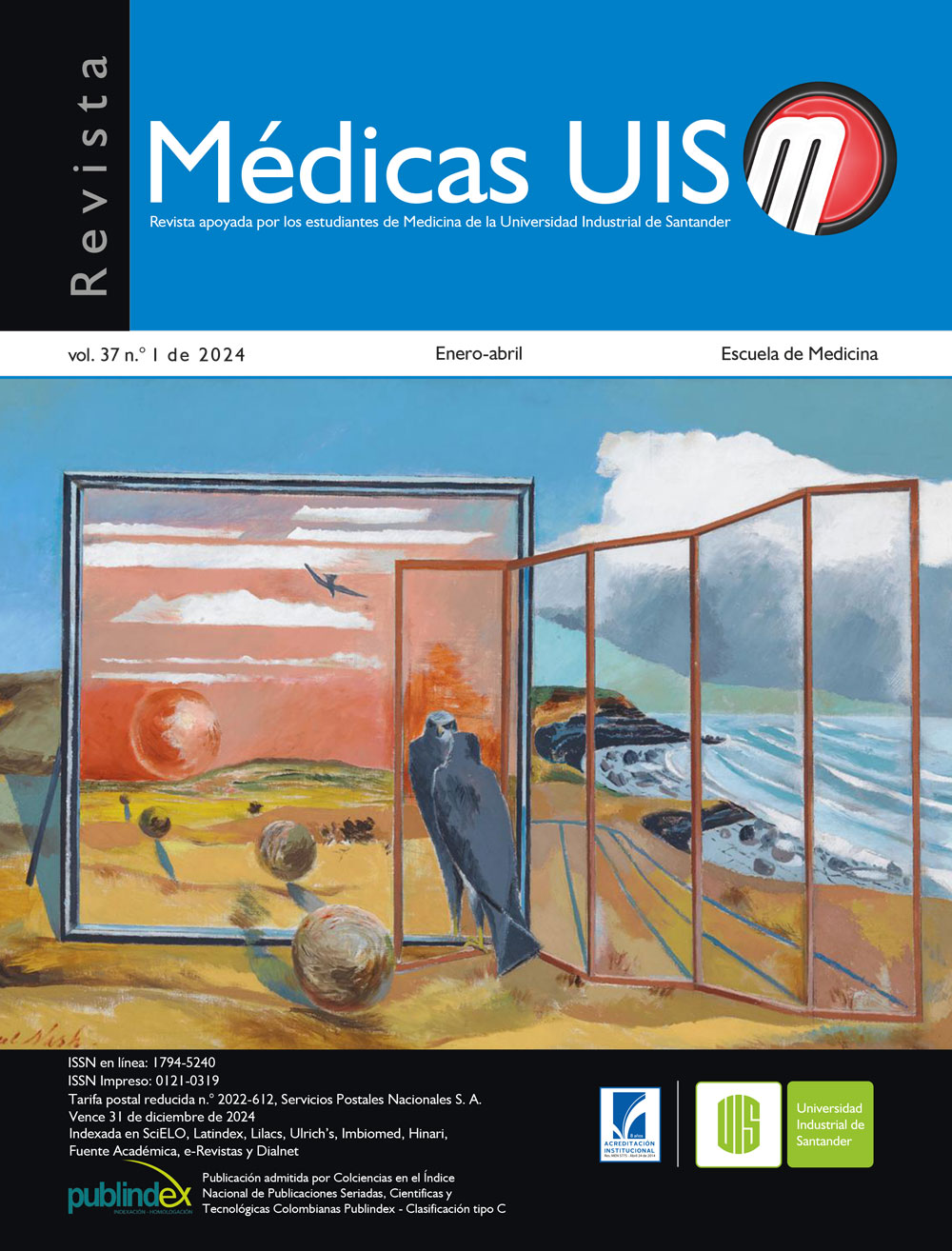Resumen
El síndrome de Boerhaave es una patología rara que conlleva una mortalidad que ronda entre el 30-50 %. Consiste en un desgarro transmural espontáneo del esófago secundario a un aumento súbito en la presión esofágica intraluminal, que en sólo tres reportes de la literatura ha estado asociado causalmente a infección por SARS-CoV-2. Se presenta el caso de un paciente masculino de 68 años con cuadro clínico de inicio súbito consistente en abundantes episodios de emesis que posteriormente presenta deterioro respiratorio, asociado a enfisema subcutáneo en hemitórax derecho. Se documenta neumonía por SARS-CoV-2 y Síndrome de Boerhaave, por lo que es llevado a esofagorrafia y dado evolución postquirúrgica tórpida, se indica terapia de vacío endoluminal con progreso favorable a los 4 meses de seguimiento. Esta patología representa un reto diagnóstico dado su inespecífica presentación clínica, por lo que el retraso en el reconocimiento impactará directamente en el abordaje terapéutico y pronóstico.
Referencias
Tarazona MAD, Chaves CER, Mateus JFI, Comba FAR, Rosso JD, Uribe MCA. Boerhaave syndrome: Successful conservative treatment. Case report and literature review. Int J Surg Case Rep. 2023;107:108289.
Tellechea JI, Gonzalez JM, Miranda-García P, Culetto A, D’Journo XB, Thomas PA, et al. Role of Endoscopy in the Management of Boerhaave Syndrome. Clin Endosc. 2018;51(2):186-191.
David A. Katzka. Trastornos esofágicos causados por fármacos, traumatismos e infecciones. En: Feldman M, Friedman LS, Brandt LJ, editores. Sleisenger Y Fordtran Enfermedades Digestivas Y Hepáticas. Barcelona: Elsevier, Inc; 2022. p. 661-669.
Huu Vinh V, Viet Dang Quang N, Van Khoi N. Surgical management of esophageal perforation: role of primary closure. Asian Cardiovasc Thorac Ann. 2019;27(3):192-198.
Han C, Duan C, Zhang S, Spiegel B, Shi H, Wang W, et al. Digestive Symptoms in COVID-19 Patients With Mild Disease Severity: Clinical Presentation, Stool Viral RNA Testing, and Outcomes. Am J Gastroenterol. 2020;115(6):916-923.
Allaway MGR, Morris PD, Sinclair BJL, Richardson AJ, Johnston ES, Hollands MJ. Management of Boerhaave syndrome in Australasia: a retrospective case series and systematic review of the Australasian literature. ANZ J Surg. 2021;91(7-8):1376-1384.
Tellechea JI, Gonzalez JM, Miranda-García P, Culetto A, D’Journo XB, Thomas PA, et al. Role of Endoscopy in the Management of Boerhaave Syndrome. Clin Endosc. 2018;51(2):186-191.
Pezzetta E, Kokudo T, Uldry E, Yamaguchi T, Kudo H, Ris HB, et al. The surgical management of spontaneous esophageal perforation (Boerhaave’s syndrome) ‒ 20 years of experience. Biosci Trends. 2016;10(2):120-124.
Shaker H, Elsayed H, Whittle I, Hussein S, Shackcloth M. The influence of the ‘golden 24-h rule’ on the prognosis of esophageal perforation in the modern era. Eur J Cardiothorac Surg. 2010;38(2):216-222.
Ríos ZA, Martínez HLF, Ortiz EMA, Durán H, Munitiz RV, Parrilla PP. Perforaciones esofágicas. Presentación de 23 casos. Gastroenterol Hepatol. 2000;23(8):379–383.
Schweigert M, Beattie R, Solymosi N, Booth K, Dubecz A, Muir A, et al. Endoscopic stent insertion versus primary operative management for spontaneous rupture of the esophagus (Boerhaave syndrome): an international study comparing the outcome. Am Surg. 2013;79(6):634-640.
Meloy P, Bhambri A. Esophageal Rupture Associated With COVID-19: A Novel Case Report. Cureus. 2020;12(12):e12256.
Saad A, Sharma A, Dhillon S, Jaunoo S. P-EGS25 Boerhaave’s Syndrome Secondary to Symptomatic COVID-19 Infection. Br J Surg. 2021;108(suppl 9):znab430.085.
Rahman A, Alqaisi S, Downing C. Unusual Presentation of COVID Pneumonia as Esophageal Rupture Ended With Successful Management. Cureus. 2021;13(8):e17348.
Schweigert M, Santos H, Solymosi N, Yankulov A, Fernández M, Beattie R, et al. 2016. Spotlight on esophageal perforation: A multinational study using the Pittsburgh esophageal perforation severity scoring system. J Thorac Cardiovasc Surg. 2016;151(4):1002–1011.
Elke G, van Zanten ARH, Lemieux M, McCall M, Jeejeebhoy KN, Kott M, et al. Enteral versus parenteral nutrition in critically ill patients: an updated systematic review and meta-analysis of randomized controlled trials. Crit Care. 2016;20(1):117-130.
Abdulsada M, Sealock RJ, Cornwell L, Ketwaroo GA. Endoluminal vacuum therapy of esophageal perforations. VideoGIE. 2020;5(1):8-10.
Szymanski K, Ontiveros E, Burdick JS, Davis D, Leeds SG. Endolumenal Vacuum Therapy and Fistulojejunostomy in the Management of Sleeve Gastrectomy Staple Line Leaks. Case Rep Surg. 2018 2018(1):1–3.
Gonzalez JM, Duran R, Vanbiervliet G, Lestelle V, Gomercic C, Gasmi M, et al. Double-type metallic stents efficacy for the management of post- operative fistulas, leakages, and perforations of the upper gastrointestinal tract. SurgEndosc. 2014;29(7):2013–2018.
Vidarsdottir H, Blondal S, Alfredsson H, Geirsson A, Gudbjartsson T. Oesophageal Perforations in Iceland: a Whole Population Study on Incidence, Aetiology and Surgical Outcome. Thorac Cardiovascular Surg. 2010;58(8):476–480.
Turner AR, Collier SA, Turner SD. Boerhaave Syndrome. [Actualizado 2023 Dec 4]. En: StatPearls [Internet]. Treasure Island (FL): StatPearls Publishing; 2024. Disponible en: https://www.ncbi.nlm.nih.gov/books/ NBK430808/
Wigley C, Athanasiou A, Bhatti A, Sheikh A, Hodson J, Bedford M, et al. Does the Pittsburgh severity score predict outcome in esophageal perforation? Dis Esophagus. 2019;32(2).

Esta obra está bajo una licencia internacional Creative Commons Atribución 4.0.
Derechos de autor 2024 Médicas UIS

